Freshwater
Molluscan Shells
Subfamily Unioninae
The Unioninae of Eastern and Central North America
are widespread and colorful. Several genera have
well-developed sexual dimorphism. There are also
several thin-shelled Anodonta species in
lakes and rivers of the far West (see below).
Tribe Pleurobemini
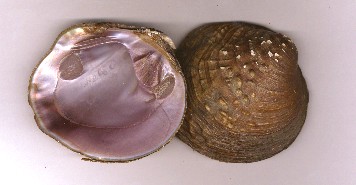 |
Cyclonaias tuberculata
(Rafinesque,1820)
"Purple Wartyback" Widespread,
American interior. |
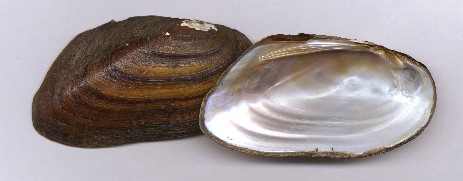 |
Eliptio complanata (Lightfoot,
1786) "Eastern
Elliptio" Wide ranging,
from Georgia to Ontario, Canada on the
Atlantic drainage. Nacre may be purple,
pink, white, or salmon. |
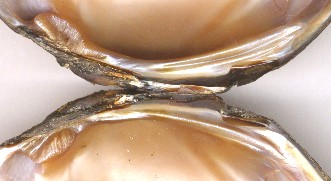 |
|
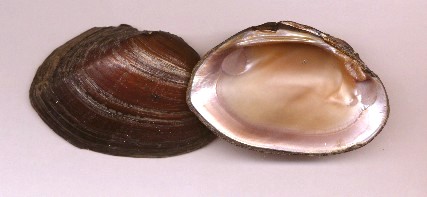 |
| Elliptio dariensis
(Lea, 1842) "Georgia
Elephant Ear" Southeastern United
States, Atlantic drainage. |
Of the 19 species of Elliptio
listed by Burch (1975), only two are widespread
in the American interior west of the Appalacians.
The remainder are largely endemic to small areas
on the Atlantic slope drainages, some Gulf
drainages of the American southeast, and Florida.
This is in contrast to North American unionaceans
an general, whose greatest diversity is in the
interior.
Regarding their origins and
dispersal across the Appalacians (Great Eastern
Divide, in part), good arguments can be made for
either: 1) colonization of the Atlantic slope
rivers from interior species, with subsequent
radiation into vacant niches on the Atlantic
slope only, or 2) colonization of the American
interior by two members of an older diversified
Atlantic slope fauna. Until the clams that did it
are captured and interviewed, we will probably
not be sure. Please see http://www.biosci.ohio-state.edu/~molluscs/Elliptio/index.htm for comprehensive information on this
group.
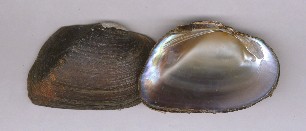 |
|
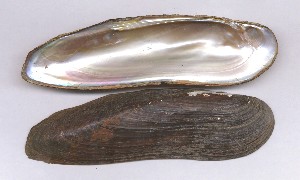 |
| Elliptio sp., central Georgia. |
|
Elliptio shepardiana
(Lea, 1834)
"Altamaha Lance".
Georgia rivers. |
Tribe Anodontini
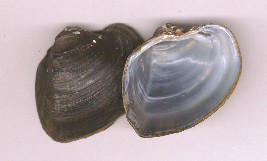 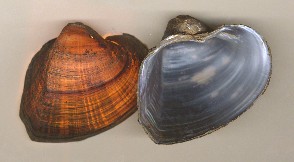 |
| Alasmidonta arcula (Lea, 1838) "Altamaha Arc-mussel"
Georgia. Right specimen is back-lit with
incandescant light. |
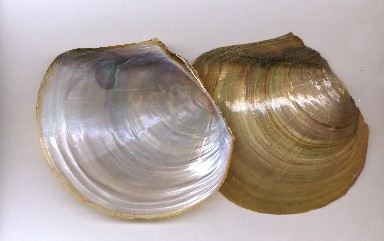 |
Anodonta suborbiculata Say,
1831.
"Flat Floater"
American interior lowlands. |
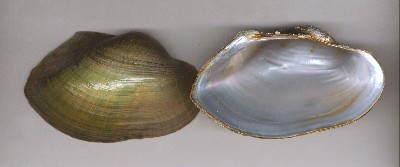 |
Anodonta (Pyganodon) gibbosa
Say, 1824, "Inflated
Floater" Southeast
Atlantic drainage of the United States.
The widespread Anodonta (Pyganodon)
grandis Say, 1829 of the North American
interior is similar, but usually lacks the
green rays. |
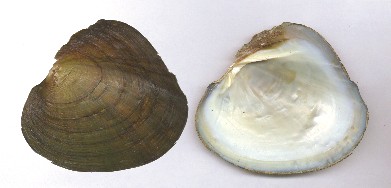 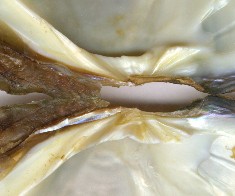 |
| Lasmigona complanata (Barnes,
1823) "White
Heelsplitter" Widespread in American and
Canadian interior. |
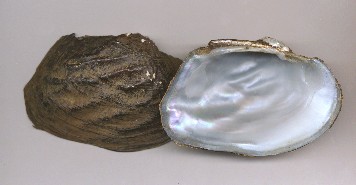 |
Arcidens confragosus (Say, 1829)
Rock Pocketbook. American
Midwest lowlands. |
Lasmigona complanata, Potamilus ohioensis,
Potamilus alatus, most Leptodea species
(see below), and several others are more or less alate
or winged. This characteristic has evolved in
unionacean mussels more than once, in Africa, Asia,
South America, and North America. The
"wings" are extensions of composite shell
material above the ligament, connecting the two
valves at a sharp fold. This material is elastic and
semi-flexible when wet and, like the ligament,
tensioned against the adductor muscles to open the
shell. The wings are best developed in young
individuals, tending to break and frazzle as the
animal matures. They become much more brittle when
dry. For alate members of the family unionidae, any
attempt to divide the two halves of the shell causes
them to crack unevenly, like a chicken wishbone.
Alate species tend to be thin-shelled, but many
thin-shelled species are not. The function of the
wing is unknown, but may be to protect the ligament,
alter the flow of water over the siphon, or protect
the siphon as the animal pulls itself forward through
the substrate. It also causes the valves to press
open more forcefully when the adductor muscles relax,
an effect that could help the animal stay open as it
moves. See http://members.aol.com/savetheclams/AsiaUnios.html
(this site) for some more extreme examples.
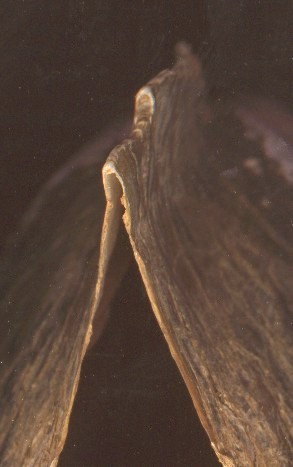 |
|
|
Scanned image (left) of Potamilus
alatus wing.
Sketch below is interpretative, showing what
you
might see if you cut through a dried specimen
more
or less across the ligament, out of view in
the scan.
The small cross-membranes may not be present,
and tend to run parallel to the ligament or
curve
down to meet it. The ligament thins to become
membranous posteriorly.
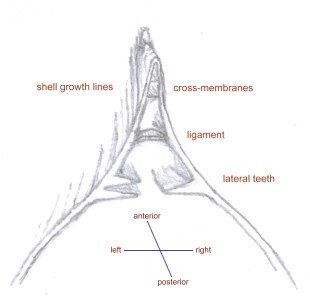 |
Tribe Lampsilini
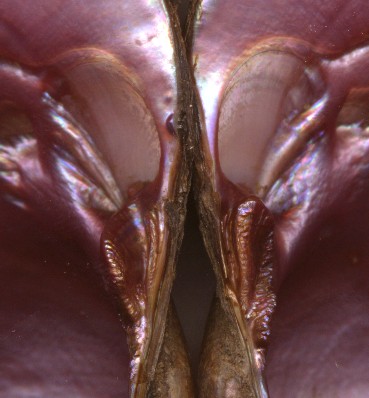 |
|
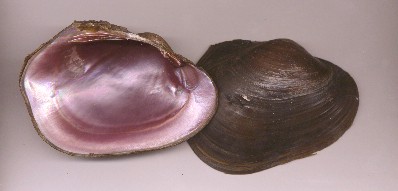
Potamilus purpuratus (Lamarck, 1819)
"Bluefer"
Widespread, lowlands of the American
interior, and detail of hinge teeth, left. |
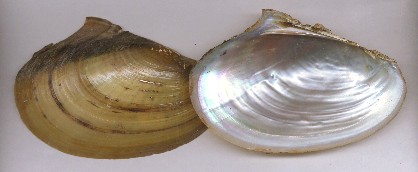
Leptodea fragilis (Rafinesque, 1820)
"Fragile papershell"
American interior. |
|
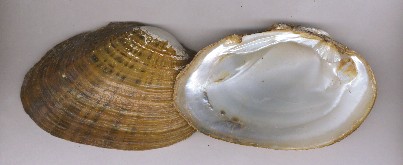
Actinonaias pectorosa (Conrad, 1834)
"Pheasantshell" Mid-south rivers. |
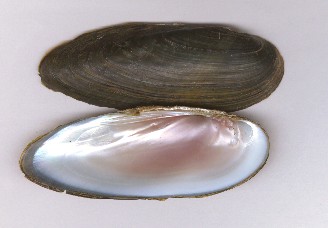
Ligumia recta (Lamarck, 1819)
"Black Sand Shell"
Widespread, American interior. |
|
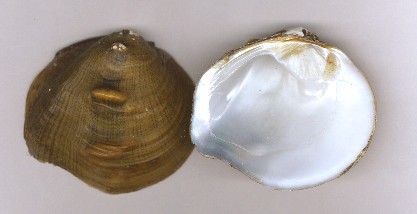
Obliquaria reflexa Rafinesque,
1820 "Threehorn"
American interior. |
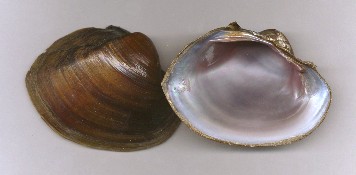 |
Lampsilis dolabraeformis (Lea,
1838)
"Altamaha
pocketbook" Georgia. |
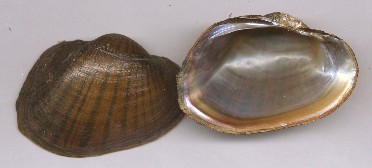
Lampsilis splendida (Lea, 1838)
"Rayed pink fatmucket" Georgia. |
|
|
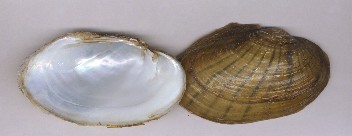
Lampsilis siliquoidea (Barnes, 1823)
"Rayed fatmucket"
Northern and western
American interior. |
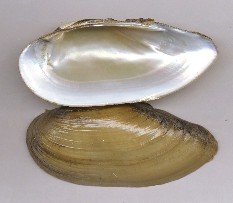 |
|
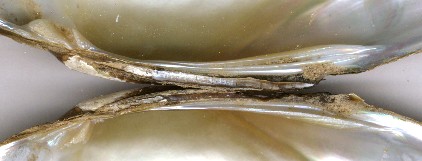 |
| Lampsilis teres
(Rafinesque, 1820) "Yellow
Sandshell" American south and interior. |
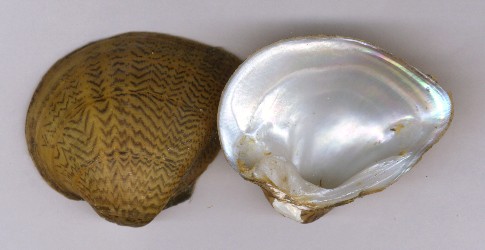 |
Truncilla truncata
Rafinesque, 1820. "Deertoe"
American interior. |
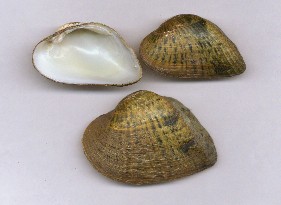 |
Epioblasma triquetra
(Rafinesque, 1820) "Snuffbox"
Female on top, large male shell below.
Members of this
genus have been among the hardest hit by
environmental
degradation during the Twentieth Century.
American interior. |
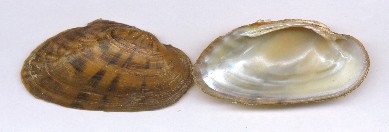 |
Ptychobranchus subtentum (Say,
1825)
"Fluted Kidneyshell"
American mid-south. |
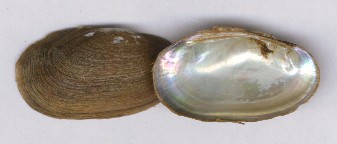 |
Toxolasma parvus (Barnes, 1823) "Lilliput"
Widespread in American interior and south. |
North American
far West (including mussels not within the subfamily
Unioninae)
Burch (1975) lists only eight
unionacean species in the Pacific drainages of
the far West, most in the larger rivers of the
Pacific Northwest.
See http://216.239.57.104/search?q=cache:7z1lpCGtwIQJ:columbiariver.fws.gov/pdfdocs/habitat/Proceedings.pdf&hl=en&ie=UTF-8
(http://columbiariver.fws.gov/pdfdocs/habitat/Proceedings.pdf)
for recent work on western United States
unionaceans.
Margaritiferidae
Margaritifera falcata (see http://members.aol.com/savetheclams/Margaritiferidae.html this site.
Unionidae
Ambleminae
Gonidea
angulata
Unioninae
Anodonta
beringiana
A. californiensis
A. dejecta
(probably extinct)
A. kennerlyi
A. nuttaliana
A. oregonensis
Gonidea angulata
(Lea, 1838) Western
ridgemussel.
Northwestern rivers. Hinge teeth are
vestigial or lacking,
periostracum is greenish in transmitted
light. The "ridge"
is said to become better developed the
farther north you
go, almost lacking in individuals towards
the southern end
of their range.in central California.
This specimen is from
the Oregon Coast Ranges
|
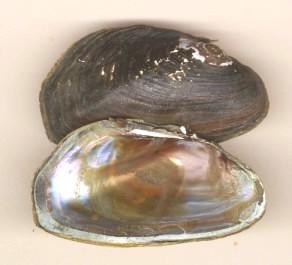 |
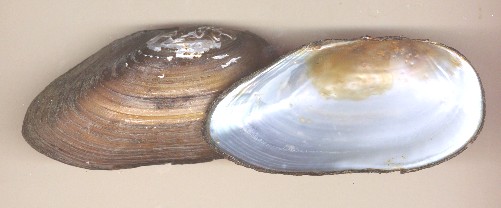 |
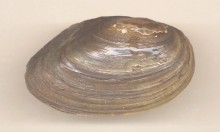
Anodonta kennerlyi Lea, 1860
Pacific Northwest. These are
from the large lakes
in the vicinity of Seattle. Most Anodonta
species
seem to change shape as they mature. An
immature individual (left) from the same
location,
is substantially rounder and flatter. |
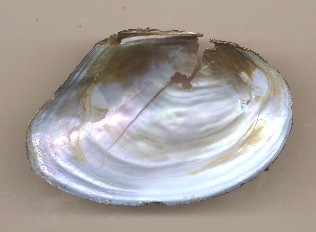 |
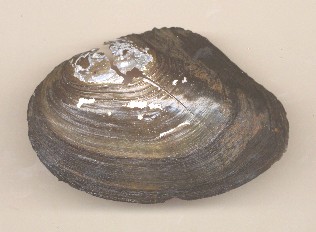 |
Anodonta nuttalliana
Lea, 1838. Rivers near
Portland. Cracking is typical over time as
the thin shell, high in
organic material, dries and shrinks unevenly. |
[Home Page] [Site Map]
|


































